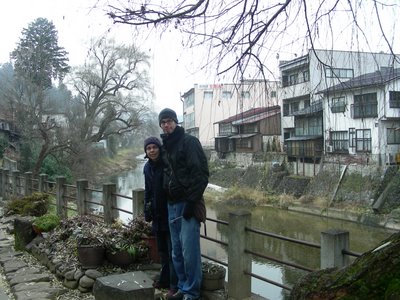 This was one of the farming villages we passed along the way. The area is famous for its beef, mountain vegetables, river fish, and green tea.
This was one of the farming villages we passed along the way. The area is famous for its beef, mountain vegetables, river fish, and green tea.
Here is a view down from the surrounding hills on part of Takayama. This part of the town is still maintained the way it was hundreds of years ago--a patchwork of small homes and barns surrounded by vegetable beds and a family grave plot (side by side).
By far one of the best parts of Takayama was the was the hostel--housed within a fully functioning Jodo Shinshu (Pureland) Buddhist Temple. We had a hot breakfast every day cooked by the Priest's wife (miso soup and rice and pickles). There was also a huge, hot steaming communal bath which we enjoyed tremendously after coming in from the cold. The hostel genkan (main entrance) is depicted at the right.
There was also a huge, hot steaming communal bath which we enjoyed tremendously after coming in from the cold. The hostel genkan (main entrance) is depicted at the right.
The rare group photo! On the morning of the 22nd we set out for the old town and folk village with Kate, an energetic Canadian grad student in Japan for the winter break (and our photographer, in this case).
The streets of Takayama's old town are generally preserved as they were one or two hundred years ago. Although so-called "preserved towns" in Japan serve primarily as tourist attractions, they are 'lived' centers nevertheless and keep alive many of the old traditions of Japan, much like Japanese temples and monasteries. Takayama is spliced by at least three or four mountain rivers, as well, most of which are still contained by old stone flood walls. Cherry trees were everywhere, so the town must be gorgeous in the spring.
Takayama is spliced by at least three or four mountain rivers, as well, most of which are still contained by old stone flood walls. Cherry trees were everywhere, so the town must be gorgeous in the spring.

Along the way we enjoyed some of Takayama's delicacies--small taiyaki (fish shaped pancakes)filled with red beans and chocolate, gosei mochi (grilled mochi shaped like olf Japanese money and smothered in a delicious miso and sesame seed sauce) and skewers of Hida beef.
This first picture is of me and Bradley out in front of the lake in front of the Hida Folk Village--an "outdoor" museum centered around a number of Gassho-zukuri (thatched) style farmhouses that were slated for demolition during the period of dam-buildingling that lasted from the 1950's to the 70's.

Unfortunately the sun was beginning to set just as we arrived and so many of our pictures came out pretty dark and a little hard to make out.

Christo, Kate, and Bradley warming their hands around a traditional hearth...
Walking among the old houses it was easy to imagine oneself in old Japan, or at least on the set of a Kurosawa film. The day we went, however, the folk villages was almost completely deserted which made me feel a bit like a ghost floating around buildings which would once have been alive with the bustle of huge extended families, bright fires, and the smells of cooking food.
In no other country I have visited is the contrast between the old and the new so pronounced.
